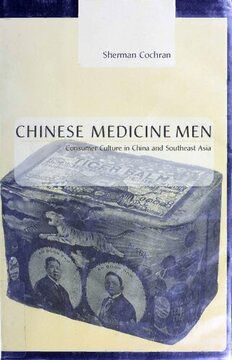Table Of ContentSherCmoacnh ran
CHINEMSEED ICMIENNE
ConsumCeurl tiunrC eh inaan dS outheAassita
' ,
' --~~,---�--
✓
-• ;.,. .
·.!HR�fNC _gCHRA�R ECONSIDERS
thnea tuarnredo loefc onsucmuelrti unr e
chscp reoafcd u ltgulroabla liHzea tion.
movbeesy otnrda didteiboanotaveles r
Westienrfnl uoennn oc-neWs etecrunl tures
roe xamtihnpeeo iwnhtesCr hei nese
entrepraennCdeh uirnse seb-uoswined
nesismeesr awcittcehod n sumers.
focusoinrn hgme a rkeotfmi endgi chien e,
shohwosw C hinceosnes trcuocntseudm er
cultiunCr hei annaSd o uthAesaiasant d
extenidoten td h leo cnaalt,i oannadl ,
transnlaetviTeohlnrsao.lut ghuhes oef
advercipsheomreomgsar,na mdpah pss,,
hei llustthvreai tsfeuosar ltm hsCa hti nese
enterapdroipsatenestdd h fea r-flung
marktehrersye ached.
Cochbrraintn ogl si gehntd urfienagt ures
oft hCeh ineexspee rwiietnchco en sumer
cultSuurrev.e tyhipene gr iboedt wteheen
88oasn tdh e5 0sh,eo bsetrhvaets
1 19
Chinb�ussei nseusrspeasts hseWeiedrs tern
counteirncp aaprttusCr hiinngae nsde
SouthAesaissatan lo efms e diciinbn oet h
peaceatniwdma er tiHmepe r.o vides
reveaelxianmgpo lfCe hsi neenster epre•
neudresa'l wiintCghhs i ne. sc
\
(continue
CHINEMSEED ICIMNEEN
SHERM.NA COCHRAN
CHINESE
MEDICINE
MEN
ConsuCmuelrti unr e
ChinaS outhAesaisat
and
----------
HARVARD UNIVERSITPYR ESS
Cambridge, Massachusetts, and London, England • 2006
FoMra cCuo,l Bliyal,nlJ d,u ne
Copyr©i 2g0h0bt6y t hPer esiadnFeden ltl oofHw asr vCaorldl ege
Alrli grhetsvsee rd
Prinitnte hUden itSetdao tfAe mse rica
Library of Congress Cataloging-in-Publication Data
CochrSahne,r m1a9n4,0 -
Chinmeesdei cmiennce:o nsucmuelrti unCr hei annaSd o uthAesai/sa t
ShermCaonc hran.
p.c m.
Inclbuidbelsi ogrreafpehriaecnniadcnl ed se x.
ISB0N- 674-02161-4
1C.o nsubmeehra vior-Chin2a.C- oHnissubtmeoehrray v.i or-Southeast
Asia-Hi3s.Pt oopruycl.ua lrt ure-Chin4aP.-o Hpiucslutalortr uyr.e
SouthAesaisat- -H5i.Ds rtuogrsy.- MarIkT.ei ttilneg..
HF5415.3230.0C66 C63
306.5310-9d c2220 05043546
ACKNOWLEDGMENTS
"Can I use advertisements in my research?" I asked my academic adviser,
Jonathan Spence, when I was a graduate student more than thirty years
ago. He agreed that it was worth a tr and since then I have asked many
y,
other people the same question in various forms as I have sought help
with a series of projects, especially this one. The people on the receiving
end of this question have given thoughtful and helpful answers even when
my topic seemed remote from their fields of specialization. My thanks go
to all of them, including the ones whose names are not included here.
For comments on the original manuscript for this book, I am grateful
to Beatrice Bartlett, Michael Hunt, Michael Kammen, Peter Katzenstein,
Thomas Lyons, Robert J. Smith, Jonathan Spence, and two anonymous
readers for Harvard University Press. For comments on parts of it, I wish
to thank Robert Culp, Sara Friedman, Takeshi Hamashita, Gail Hender
son, Andrew Hsieh, Ping-chen Hsiung, Susan Naquin, and Sidney Tarrow.
For the making of the maps, I owe a debt to Thomas Lyons and Eric
Singer, and in trying to see what the illustrations signify, I was fortunate to
be able to consult Jeffrey Cody, Kerry Fan, Johnathan Farris, Lai Delin, and
Martie Young. These friends and colleagues have challenged me to rise to
their high standards, and I take the blame for the places where I have fallen
short.
Without archives this book would not have been possible. In Hong
Kong, Sally Aw and Sharon Tsang kindly gave me access to the Aw Boon
haw Archives. In Singapore, Lily Tan introduced me to the Singapore
National Archives. At the Shanghai Municipal Archives, Feng Shoucai and
Ma Changlin have served faithfull while access to their institution's col
y,
lections has broadened spectacularl Since the founding of the Shanghai
y.
Municipal History Museum, Pan Junxiang has been my guide there. At
Acknowledgments
th Center for Research on Chinese Business History in the Shanghai
cademy of Social Sciences, my close colleagues Cheng Linsun, Huang
Hanmin, Lu Xinglong, Shen Zuwei, Zhang Zhongli, and Zhang Zhong
min have provided me with the most crucial help of all. They have put in
my hands valuable unpublished source materials that have come from
outside as well as within their own center, and they have repeatedly
opened doors that would otherwise have been closed to me.
My research in these archives and elsewhere would not have been fea
sible wjthout financial support. For a grant that covered the costs of
research in East Asia, I want to thank the Henry Luce Foundation for
Asian Studies in New York. For fellowships that gave me the opportunity
to write this book, I am grateful to the Woodrow Wilson International
Center for Scholars, Washington, D.C., and the National Humanities Cen
ter, Research Triangle Park, North Carolina. For research assistance, I
have had funding from the Department of History and the East Asia Pro
gram at Cornell. My research assistants have included Christoph Giebel,
Patrick Hess, Xiaojia Hou, Ningkang Jiang, Haiyan Lee, Conny Mar
quardt, Eric Singer, and Liren Zheng. They have made significant contri
butions to this book, and Dr. Zheng, a specialist in Southeast Asian as well
as Chinese history, has made the greatest contributions of all.
In this project I have benefited from skillful editorial assistance every
step of the way. At Cornell, Katie Kristof worked with early drafts of
chapters. At the National Humanities Center, Karen Carroll put the man
uscript in proper form. For Harvard University Press, Ann Twombly
edited the manuscript precisely and constructively-even moreso than is
generally expected at a distinguished academic press-and Kathleen
McDermott and Susan Abel gracefully presided over the transformation
of the manuscript into a book. Operating from her own home, Kathryn
Torgeson expertly added the index.
While writing this book, I have depended heavily on my loved ones to
see me through a time of personal loss and recovery, and I am grateful for
the chance to dedicate it to members of my family: my sister, brother, and
sister-in-law for sustaining me through thick and thin, and my wife for
opening the way into the future.

